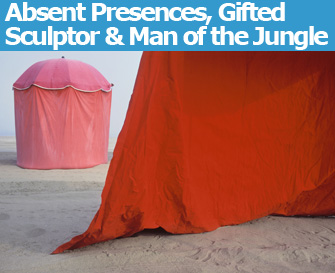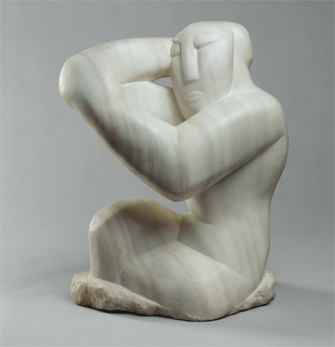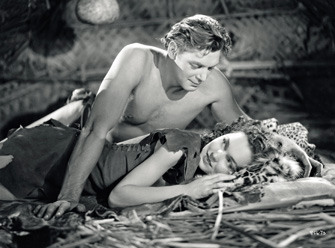 |
| From John Batho’s “Parasol Series” (1981-2002). © John Batho. |
The exhibitions reviewed below – “John Batho: Le Champ d’un Regard,” “Henri Gaudier-Brzeska” and “Tarzan!” – have nothing in common except that …
 |
| From John Batho’s “Parasol Series” (1981-2002). © John Batho. |
The exhibitions reviewed below – “John Batho: Le Champ d’un Regard,” “Henri Gaudier-Brzeska” and “Tarzan!” – have nothing in common except that they all offer an enjoyable summer interlude.
“John Batho: Le Champ d’un Regard”
John Batho (b. 1939) is a surprising photographer whose work can’t be pigeonholed but is consistently powerful in every style he uses. “John Batho: Le Champ d’un Regard,” a lovely show at the Bibliothèque Nationale de France (through September 6), presents a selection of highly varied works from different periods of his career, beginning with a recent series of large-format black-and-white photos of what look like X-ray images of disappearing people (the subjects are posed behind misty sheets of glass). Human beings seem to appear only as shadows or “absent presences” in Batho’s work.
Other strong black-and-white images include a stunning series of abstract studies of the effects of light on paper, and another of the effects of shadows on everyday objects.
Those black-and-white photos are subtly beautiful, but when Batho turns to color, he positively dazzles, with a handful of green peas on an orange surface, for example, or two yellow-suited swimmers in pale-blue water. Unlike many photographers who stick to one or the other, Batho switches from color to black-and-white as inspiration leads him and is a master of both. He started using color in the early 1960s, when the medium was still dominated by black and white. As always at the BnF, this show is handsomely displayed.
Bibliothèque Nationale de France: 58, rue de Richelieu, 75002 Paris. Métro: Bourse or Palais Royal. Reservations: 0892 684 694 (FNAC). Open Tuesday-Saturday, 10 a.m.-7 p.m.; Sunday, noon-7 p.m. Closed Monday and public holidays. Admission: €7. Through September 6. www.bnf.fr
Henri Gaudier-Brzeska
 |
| “Femme assise” (1914) byHenri Gaudier Brzeska. © Adam Rzepka |
Henri Gaudier-Brzeska (1891-1915) may not be a household name, but this French sculptor had already made a mark on the art world by the time he was killed in World War I at the age of 23 and is still considered an important Modernist. The Centre Pompidou is holding a small show of his works from its own collections and those of the Musée des Beaux-Arts d’Orléans through September 14.
Four years before his death, Gaudier-Brzeska moved to London, where he was befriended by sculptor Jacob Epstein and writer Ezra Pound. This show of his sculptures and drawings points up the great tragedy of his early death by demonstrating just how big his talent already was. His drawings and sketchbooks (three of which are shown page by page on video screens and are worth watching) reveal his natural talent and dedication to his art, and the sculptures show him to be self-assured (he classed himself right up there with Brancusi, Epstein and Modigliani) and highly productive. While he may still have been experimenting and finding his way stylistically, he was already an accomplished artist. One can only wonder what direction his work would have taken had he had the time to continue.
Centre Pompidou: 19, rue Beaubourg, 75004 Paris. Tel.: 01 44 78 12 33. Open 11 a.m.-9 p.m. Closed Tuesday. Métro: Rambuteau. Admission: €10-€12. Through September 14. www.centrepompidou.fr/
“Tarzan!”
 |
| Johnny Weissmuller and Maureen O’Sullivan in “Tarzan Escapes.” © 1936 Turner Entertainment Co. |
Is Tarzan the missing link? A superhero? A wild child? A wise ape? A fallen angel? An environmentalist before his time? He has been all of these things at various times to various people ever since the character of the vine-swinging, yodeling man of the jungle was created by Edgar Rice Burroughs (1875-1950) in a series of 26 novels published beginning in 1912. The exhibition “Tarzan!” at the Musée du Quai Branly through September 27 goes back to the source of the legend in Burroughs’ books and then looks at how the story of Tarzan the Ape Man was later interpreted, embroidered and deformed in myriad ways by films, comic books, toys, dolls, posters, clothing (e.g., a leopard-skin bikini), advertisements and other spinoffs of a legend that obviously tapped into the collective unconscious and still fascinates.
When he visited the Chicago World’s Fair in 1893, Burroughs discovered and was captivated by a fake version of Africa, complete with a fake village and fake dances; he never actually set foot on the African continent. His story, which shows the influence of the myth of Romulus and Remus and Rudyard Kipling’s The Jungle Book, has inspired no fewer than 46 films.
Bring the kids to this exhibition, which is full of blown-up comic book pages, taxidermied animals (including a lion and leopard), film clips, toys and kitschy products like Tarzan salt shakers. There are also African masks and some scary-looking dolls from a secret society of assassins.
Musée du Quai Branly: 206 or 208, rue de l’Université, or 27, 37 or 51, quai Branly, 75007 Paris. Métro: Alma Marceau. RER: Pont de l’Alma. Tel.: 01 56 61 70 00. Open Tuesday, Wednesday and Sunday, 11 a.m.-7 p.m; Thursday, Friday and Saturday, 11 a.m.- 9 p.m. Admission: €7 (this exhibition only), €10 (temporary exhibitions and permanent collection). Through September 27. www.quaibranly.fr
Buy related books and films from the Paris Update store.
More reviews of current art exhibitions.
Reader reaction
Click here to respond to this article (your response may be published on this page and is subject to editing).
© 2009 Paris Update
Favorite